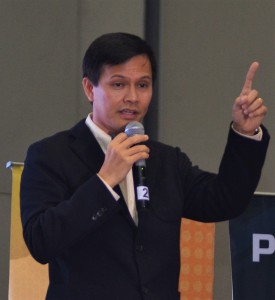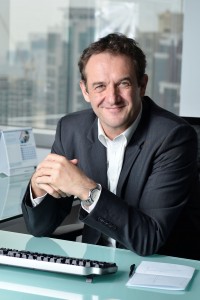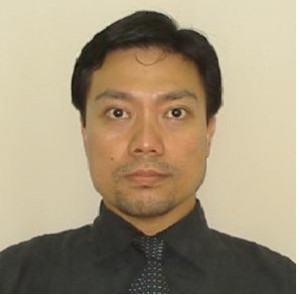2016 Outlook, part 4
By Randell Tiongson on January 27th, 2016
For this installment of the 2016 Outlook, it is both an honor and a privilege to present the views of one of the most respected fund managers of the country.
————
The 2016 Outlook of Marvin Fausto
2015 was quite a challenging year for the investing public given the volatilities of the markets both for the bonds and equities. In fact, the best asset class that performed last year was deposit or money market funds since the market values of bond funds and equity funds were down as of year-end compared to the start of the year. Returns of these investments were negative on average. Many economists and analysts point to figures that trended below expectations. GDP growth for one is turning out to end 2015 near the 6% level, a full notch below Government’s forecasts of above 7%. Interest rates increased much faster that affected bond returns while earnings of stock exchange listed companies went through a series of downgrades throughout the year giving disappointing growth rates that caused much stock market selling towards the latter part of the year.
I mentioned in my report to Randell’s column last year that investments will be data dependent and that should numbers disappoint, such as the country’s GDP growth, investors will move accordingly.
“…the premium that investors give to the Philippines may be given a second look and will be adjusted accordingly”.
For the stock market, my view on investment strategy was more of a trading opportunity.
“With valuations remaining above historical levels and as trading volumes decline, stock market traders should remain selective and increase positions during market downturns and reduce holdings during market rallies”.
2016 will be a continuation, in my view. As the great unwind unfolds – that is, when the largest economy as the USA reverse the 7-year-long liquidity push stemming from near zero interest rates to spur economic activity – markets will react accordingly. The asset price excesses brought about by investors’ search for higher yields outside of the US is now reversing back home as the US dollar strengthens and the rest of the world, including China, currencies weaken. As we go through this period of reversal, higher than historical volatility is to be expected. Human behavior, particularly of those that have only experienced a bull market (or investors only since 2009), may undergo a long drawn phase of anger and denial until the point of indifference. For the Philippines, the added uncertainties brought about by election results and the potential weakening of OFW remittances will not help stabilize confidence. Even as the economy is expected to remain resilient at above the 6% GDP growth rate, confidence on the bond market as well as the stock market will remain cautious.
At this point, investors are well advised to take a step back and not lose sight of why they are investing in the first place. Investing should first and foremost be for a purpose, for a reason, and for a need. Markets go up and down. That is how it works. Match goals with risk appetite and horizon, implement your strategy, and let the markets run its course.
————-
 Marvin V. Fausto is President of the IFE Financial Advisers, Inc.. He was the former Senior Vice President and Chief Investment Officer of the country’s largest bank, BDO Universal Bank and in charge of the Investments unit managing over P700 Billion under the BDO Trust Banking Group. He recently took his early retirement having worked for over 30 years in the fund management industry and is now embarking on a new venture as a consultant to COL Financial to launch the first fund supermarket in the country making funds available online and easily accessible to everyone.
Marvin V. Fausto is President of the IFE Financial Advisers, Inc.. He was the former Senior Vice President and Chief Investment Officer of the country’s largest bank, BDO Universal Bank and in charge of the Investments unit managing over P700 Billion under the BDO Trust Banking Group. He recently took his early retirement having worked for over 30 years in the fund management industry and is now embarking on a new venture as a consultant to COL Financial to launch the first fund supermarket in the country making funds available online and easily accessible to everyone.
He held the position as head of the Trust Banking Group of Equitable PCI Bank from 2002 to 2007 primarily responsible for its overall business and operations. He also held the position of Vice President and Investments Head at Citytrust Banking Corporation. He started his career as an analyst at the former Far East Bank & Trust Co.
After having served as President and director, Mr. Fausto is currently a Board Adviser to the Trust Officers Association of the Philippines, the umbrella organization of the Trust Industry. He was also the Founding President and current Board adviser of the Fund Managers Association of the Philippines. He is also a member of the Board of Advisers of the CFA Society of the Phils.
2016 Outlook, part 3
By Randell Tiongson on January 21st, 2016
For the 3rd installment of my 2016 Outlook series, I am honored to present the views of the CEO of one of the largest insurance companies in the country today, AXA Philippines.
————–
The 2016 Outlook of Rien Hermans
This 2016, I see several positive factors across the key markets. They inevitably come with various degrees of risk as these markets undergo various political and economic transitions. This year will be by no means smooth sailing and the volatility of the market will be high, but quite clearly, there are several growth opportunities over the medium and long-term that seem to offer stable growth.
China’s economic slowdown— and its subsequent impact in markets across the globe— has created concerns, with the recent stock market lock-down seeming to reinforce a growing aversion for China exposure. But while its days of hyper-GDP growth are over, the Chinese economy is still expected to grow reasonably well 2016 and beyond, subject to the Chinese government’s ability to implement the proper reforms. Volatility is to be expected as it transitions from a manufacturing-reliant economy, to a more sustainable consumption driven one.
This transition will inevitably impact most emerging markets, particularly those in Asia. But as a whole, Asia is still expected to drive global growth over the next 3 years. The Philippines and its consumption driven economy in particular, remains well-positioned for a defensive economic theme amidst the global volatility. Understandably, the eventual results of the presidential election may potentially impact the degree of acceleration, but will not alter the upwards trajectory. The country’s economic fundamentals remain on solid footing, and shall remain through the political transition, pointing to sustainable economic growth.
The US has been recovering and recent figures show modest economic growth, which is expected to continue in the coming years and allows a slight increase in interest rates. The dollar can further strengthen against both the Euro and the Peso. The stock market in the US, which has been recovering over the past two years, is expected to show a slight positive growth, with the expectations that sectors like the digital oriented stocks will outperform.
I expect the European markets to outperform the global markets in 2016, as Europe has clearly started its recovery and economic growth is expected in the major economies within the Euro zone. This will further be accelerated by the stronger competitive position as a result of the lower Euro.
This 2016, the best strategy seems to be to diversify and have a long-term mind-set. Balance investments among markets with a strong consumption theme, like the Philippines, while considering developed markets like Europe and include some exposure in US-denominated funds to benefit not only from the growth of the overseas markets, but also from the stronger currency.
—————–

Convinced of the value that financial products deliver to customers Rien has spent over 2 decades in the financial service industry in the fields of product development, distribution, marketing, strategy and general management.
In 1990 he started with ING Bank in the Netherlands, where he was responsible for developing and implementing Life insurance as a new product group offered by the bank. His analytical skills and strategic vision were recognized and for 4 years he was vice president Strategy & Planning advising the Board of ING on strategic issues.
In 1999 he moved to Asia and after a short stint in Hong Kong he was assigned as the CEO of ING Life as well as CEO of Aetna Life & Healthcare in the Philippines, Executive Director and General Manager of ING Malaysia and the last position he held in ING was Board Member of ING Financial Services Poland.
In 2009 Rien ‘crossed the line’ and joined AXA with the assignment to transform AXA Philippines into a strong player on the domestic market with a sustainable position in the top 5. Focused to be the best in the eyes of the customers the company has strengthened its position in the growing life insurance and investment market in the Philippines.
2016 Outlook, part 2
By Randell Tiongson on January 19th, 2016
This installment will showcase the views of James Lago of PCCI Securities Brokers Inc.
James is one of the most insightful and in-depth analyst I know and this is because he sees things from a big picture approach being an economist and an analyst at the same time.
—————-
Economy – For 2016, our initial GDP growth forecast range is 5.8% –
6.0%. This baseline assumption is premised on the following growth
rates of the major industry groups: industry growing by about 5.3%,
services expanding by 6.0% and agriculture posting a 1.0% growth. On
the expenditures side, we see household spending (HFCE) rising by 5.9%
– 6.4% as the continued decline in energy prices will still translate
to additional disposable income. The major election year historical
contribution to GDP is likewise considered.
Should the lower energy prices environment continue, we forecast 2016
inflation to remain manageable. Factoring in our anticipated
peso-dollar exchange rate this year, our initial yearend CPI range
forecast is 146.0 – 147.0 resulting in an average inflation forecast
ranging from 2.0% – 2.3% using the 2006 base year.
PSEi – The bullish trend since its recovery in 2009 remains intact. A
new historic high of 8,136.97 was recorded as the bull market entered
its 7th consecutive year last year, surpassing our most optimistic
estimates but was certainly short-lived.
2015 starts with an unfolding minor correction phase and the leading
relative valuations still above its historical averages, and at a
premium to the regional average anew. Since only a 23.8% correction
of the 2009 – 2015 uptrend was achieved, the corrective phase may
still continue in to 1H 2016 before a real rebound unfolds. Most
corporate earnings will continue to improve even at a base case of a
slower growth rate compared to 2015. Our base case scenario for the
PSEi this year is minor supports of the ongoing healthy correction at
6,200 and 6,000 before a recovery to 7,000 – 7,300. Undoubtedly, the outcome of the Presidential elections will sway investor confidence.
Peso – The peso depreciated as expected last year as international
investors continued to move back to dollar assets.Net portfolio
outflows primarily from equities, weak net FDI flows and lower export
receipts sent the peso to a 47.49 low, way past our 46.00 – 47.00 base
case scenario.
For this year, we see the ICE dollar index rising to at least 101.50,
as funds continue to flow back into US dollar assets given the FOMC’s
gradual interest rate normalization. The pace should not be as severe
as that in 2015. With this, our base case scenario therefore for the
peso is a depreciation to around 48.00 that will result in a 76.4%
retracement of its October 2008 – January 2013 appreciation. A further
depreciation to 49.00 is possible if the former is surpassed. While it
is currently at equilibrium at around 47.00, an appreciation back to
46.00 or even 45.00 is possible.
The PBOC’s managed weakening of the renminbi (or yuan) will not
significantly impact on the peso. We were not surprised by this
development after their initial action in August last year as the PBOC
is guiding China’s currency to a level that it believes will be
appropriate given several variables. Our base case scenario for the
renminbi is an eventual return to the RMB/CNY6.80
level.
Domestic Fixed Income Yields – Real returns on the short-term yields
turned positive by mid-year last year as inflation slowed and
investors took profits price-wise to demand higher yields ahead of the
U.S. Fed’s interest rate normalization. The yield curve underwent a
nonparallel upward shift and remained a normal yield curve at yearend.
The spread between the average short and long-term yields spread was
below our 200 – 250 bps range expectation throughout last year as the
medium and longer tenor yields did not move up significantly.
For 2016, the yield curve is also seen to remain essentially normal
with yields ranging in between early-2012 to 2013 levels. The spread
between the average short-term and long-term yields might move within
a 150 – 200 bps range and investors will continue to be opportunistic
to find ways around the yield levels. We expect corporate debt raising
and preferred shares offerings to continue this year as rates remain
affordable vis-à-vis historical levels coupled with the gradual rate
hike path in the U.S.
Portfolio Strategy – Our overall core equity strategy remains anchored
on the soundness of a firm’s core business model and its stock’s key
relative valuations, PER and PBV, trading at a discount to the PSEi’s
averages. It is also worth looking into some key index heavyweights as
the valuation premium have narrowed to reasonable levels versus the
PSEi’s averages
Taking account as well of a generally bearish market scenario and a
consumption driven GDP growth that will get an added lift from
election-related spending, high dividend yield, non-cyclicals and
baseline consumer stocks are on top of our recommendations. Should a
firming up of global equities markets occur by midyear, there should
be no hesitation to switching from a dividend yield play to capital
appreciation to improve total return.
Our recommendation for fixed income investors is still to spread out
investments over the offerings this year and several tenors for
diversification. Short-term yields are now at attractive levels
vis-à-vis inflation expectations. Positive real returns may be
harvested again.The suggested average tenor or duration of the
portfolio is it is skewed to the relative middle of the middle-tenor
ranges given that yields across the yield curve range at the start of
2016 are attractive.
 Joseph James Lago is AVP of the PCCI Securities Brokers Corp. He has over 2 decades of experience in the investments industry in various capacities. He is also a professor of the De La Salle University Graduate School teaching in Management and Economics. He is a much sought after researcher, economist and analysts. He is a Registered Financial Panner.
Joseph James Lago is AVP of the PCCI Securities Brokers Corp. He has over 2 decades of experience in the investments industry in various capacities. He is also a professor of the De La Salle University Graduate School teaching in Management and Economics. He is a much sought after researcher, economist and analysts. He is a Registered Financial Panner.
 Marvin V. Fausto is President of the IFE Financial Advisers, Inc.. He was the former Senior Vice President and Chief Investment Officer of the country’s largest bank, BDO Universal Bank and in charge of the Investments unit managing over P700 Billion under the BDO Trust Banking Group. He recently took his early retirement having worked for over 30 years in the fund management industry and is now embarking on a new venture as a consultant to COL Financial to launch the first fund supermarket in the country making funds available online and easily accessible to everyone.
Marvin V. Fausto is President of the IFE Financial Advisers, Inc.. He was the former Senior Vice President and Chief Investment Officer of the country’s largest bank, BDO Universal Bank and in charge of the Investments unit managing over P700 Billion under the BDO Trust Banking Group. He recently took his early retirement having worked for over 30 years in the fund management industry and is now embarking on a new venture as a consultant to COL Financial to launch the first fund supermarket in the country making funds available online and easily accessible to everyone.


